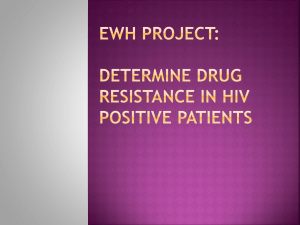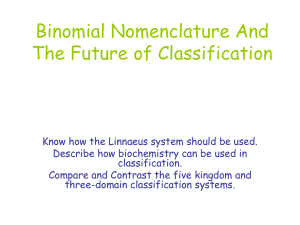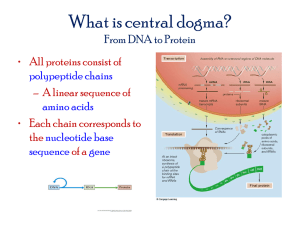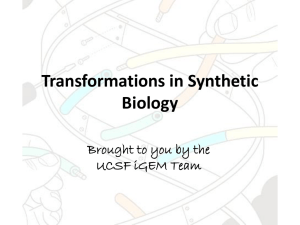Chaim Lecture 2
advertisement
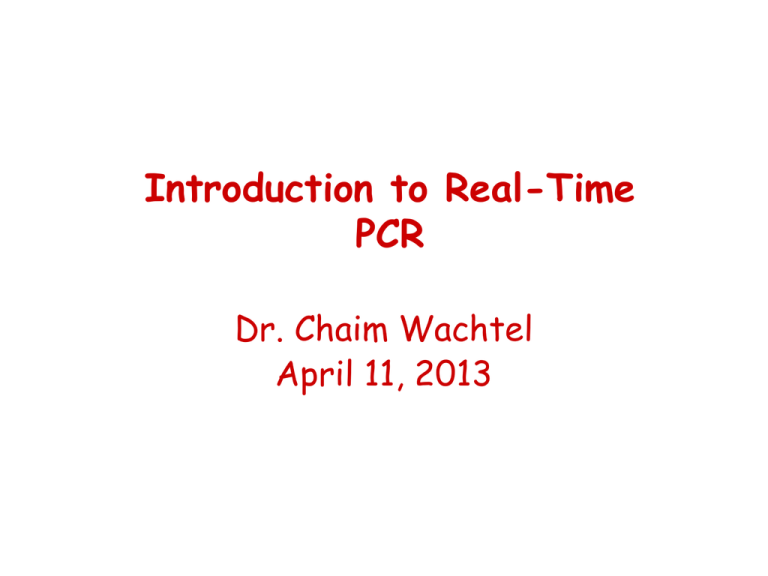
Introduction to Real-Time PCR Dr. Chaim Wachtel April 11, 2013 Real-Time PCR • What is it? • How does it work • How do you properly perform an experiment • Analysis The Nobel Prize in Chemistry 1993 was awarded "for contributions to the developments of methods within DNA-based chemistry" jointly with one half to Kary B. Mullis "for his invention of the polymerase chain reaction (PCR) method"and with one half to Michael Smith "for his fundamental contributions to the establishment of oligonucleotide-based, site-directed mutagenesis and its development for protein studies". Michael Smith PCR – A simple idea • Polymerase Chain Reaction: Kary Mullis (1983) • In vitro method for enzymatically synthesizing DNA • The reaction uses two oligonucleotide primers that hybridize to opposite strands and flank the target DNA sequence that is to be amplified • A repetitive series of cycles gives exponential accumulation of a specific DNA fragment – Template denaturation – Primer annealing – Extension of annealed primers by the polymerase • The number of target DNA copies doubles every PCR cycle (20 cycles 220≈106 copies of target) Principle of PCR Difference PCR vs real-time PCR? • Fluorescence is measured every cycle (signal amount of PCR product). • Curves rise after a number of cycles that is proportional to the initial amount of DNA template. • Comparison with standard curve gives quantification. Real-Time and End Point End point Real time MIQE: the minimum information for the publication of qPCR experiments. http://www.rdml.org/miqe.php The mRNA of the Arabidopsis Gene FT Moves from Leaf to Shoot Apex and Induces Flowering Tao Huang, Henrik Böhlenius, Sven Eriksson, François Parcy, and Ove Nilsson Science 9 September 2005: 1694-1696. 2005: Signaling Breakthroughs of the Year Retraction WE WISH TO RETRACT OUR RESEARCH ARTICLE “THE MRNA OF THE ARABIDOPSIS GENE FT MOVES from leaf to shoot apex and induces flowering” (1). After the first author (T.H.) left the Umeå Plant Science Centre for another position, analysis of his original data revealed several anomalies. It is apparent from these files that data from the real-time RT-PCR were analyzed incorrectly. Certain data points were removed, while other data points were given increased weight in the statistical analysis. When all the primary real-time RT-PCR data are subjected to correct statistical analysis, most of the reported significant differences between time points disappear. Because of this, we are retracting the paper in its entirety. Real-Time Machines • How do they work • What can you do with one – Gene expression – SNP detection – DNA detection (quantify) • How do you use them – Experiment design • Everything you need to know and more about RNA and RT-PCR First real-time PCR, 1991 spectrofluorometer fiberoptic PCR tube in thermocycler “Fifty Years of Molecular Diagnostics” Clin Chem. 2005 Mar;51(3):661-71 (C.Wittwer, ed.) First commercial real-time PCR instruments ABI 7700 – laser/fiberoptic-based ABI 5700 – CCD camera-based Idaho Technology LightCycler – capillary tubes RT-PCR machines at Bar Ilan AB StepOnePlus Fast Real-Time PCR System 7900HT Fast Real-Time PCR System (Sol Efroni’s lab) Qiagen’s Rotor-gene (Oren Levy’s lab) Bio-Rad CFX-96 Thermo PikoReal (Bachelet Lab) Rotor-gene Probing alternatives Non-specific detection Dyes: SYBR Green I, BEBO, BOXTO, EvaGreen... Primer based detection Scorpion primers QZyme Lux primers Specific detection TaqMan probe Molecular Beacon Light-Up probe Hybridization probes SYBR Green binds to dsDNA SYBR Green binds to DNA, particularly to double-stranded DNA, giving strongly enhanced fluorescence. SYBR Green is sequencedependent! Low flouresc enc e The TaqMan Probe • The TaqMan probe binds to ssDNA at a combined annealing and elongation step. • It is degraded by the polymerase, which releases the dye from the quencher. Multiplex Q-PCR 40 Fluorescence 30 20 10 0 0 5 10 15 20 25 30 35 Cycle number • Detection of two (or more) different target sequences in the same reaction. 40 qPCR technical workflow DNA Extraction Sampling qPCR RNA Extraction DNase treatment Reverse Transcription Data Analysis Nucleic acid isolation and purification Overview • Sampling • Accessibility and lysis • Commonly used techniques • RNA considerations • Quality control Why sample preparation? • Make target available • Remove inhibitors • Remove fluorescent contaminants • Preserve target integrity • Concentrate target Path Disruption Isolation mRNA Total RNA Nuclear RNA Purification RNA DNA Reverse Transcription Real-time PCR Genomic DNA Plasmid DNA Fragment DNA Phage DNA Accessibility Sample disruption and homogenization – Mechanical • Grinding, Sonication, Vortexing, Polytron – Physical • Freezing – Enzymatic • Proteinase K, Lysozyme, Collagenase – Chemical • Guanidinium isothiocyanate (GITC), Alkali treatment, CTAB Lysis – Complete or partial lysis? – Chaotropic lysis buffers: • SDS, GITC, LiCl, phenol, sarcosyl – Gentle lysis buffers: • NP-40, Triton X-100, Tween, DTT Purification principles • Characteristics of nucleic acids – Long, unbranched, negatively charged polymers • Examples: – Differential solubility – Precipitation – Strong affinity to surface • Factors: – pH, [salt], hydrophobicity Purification techniques • Solution based- eg Tri reagent, CsCl gradient • Precipitation- ethanol, needs salt, multiple factors can influence precipitation • Membrane based- spin columns (Qiagen and the like) • Magnetic bead based Solution based isolation • Most methods use hazardous reagents • Phenol/Chloroform extraction – Proteins, lipids, polysaccharides go into the organic phase or in the interphase. – DNA/RNA remains in aqueous phase • Caesium chloride density gradient ultracentrifugation – Time consuming • Acid guanidine phenol chloroform extraction – Commonly called TRIzol Precipitation purification • Nucleic acids precipitate in alcohols • Salt (NaCl, NaAc) facilitates the process • Important factors: Temperature, time, pH, and amount Membrane based isolation • Anion exchange technology • Spin column / silica gel membrane – Chaotropic salts (e.g. NaI or guanidine hydrochloride) bind H2O molecules – Loss of water from DNA changes shape and charge – DNA binds reversibly to silica membrane Purification – GITC vs. column Organic liquids • Pro: – Higher yield – Can handle larger amounts of cells – Better for troublesome tissues (fatty tissue, bone etc) Spin columns • Pro: – Less contaminating DNA (for RNA isolation) – On column DNase digestion Less loss of RNA – Higher quality – Easy to use • Con: – Higher DNA contamination (for RNA isolation) – Separate DNase I digestion with additional purification • Con: – Limited loading capacity – More expensive (?) RNA Considerations • RNA is chemically and biologically less stable than DNA • Extrinsic and intrinsic ribonucleases (RNases) – Specific and Nonspecific inhibitors Stabilizing conditions • Work on ice • Process immediately • Flash freeze sample in liquid nitrogen and store at -70°C until later use • Store samples in stabilization buffer Storage of nucleic acids • Nuclease-free plasticware • Eluted in nuclease-free water, TE or sodium citrate solution • RNA: • Neutral pH to avoid degradation • Aliquot sample to avoid multiple freeze-thaw cycles • Isolated RNA should be stored at -20 deg C or -70 deg C for even better protection in ethanol and not water. Quality Control • Spectroscopic methods – Concentration, [NA] = A260 x e mg/ml – Purity: A260 / A280 (≈1.8 for DNA, 2.0 for RNA) • Dyes – Quantification by fluorescence of DNA/RNAbinding dyes (Qubit) • Electrophoresis (28S and 18S bands) What is the BioAnalizer? • Microfluidic separations technology • RNA - DNA - Protein • 1µl of RNA sample (100 pg to 500 ng) • 12 samples analyzed in 30 min • Integrated analysis software: – Quantitation – Integrity of RNA Bioanalyzer RNA Integrity: RQI Good RNA Quality 10 RNA Quality Indicator Bad RNA Quality 1 Publications on RNA integrity DNase I treatment of RNA samples RT, No DNase No RT, No DNase RT, DNase No RT, DNase qPCR technical workflow DNA Extraction Sampling qPCR RNA Extraction DNase treatment Reverse Transcription Data Analysis Reverse transcription RT Outline • Priming efficiency • Reproducibility • Properties of Reverse transcriptase • RNA concentrations General description of RT reaction Reverse Transcriptases are RNAdependent* DNA polymerases that catalyze first strand DNA synthesis in presence of a suitable primer+ as long as it has a free 3’ OH end. *Can use also single strand DNA as template. + Can be either RNA or DNA. RT priming RT with Gene-Specific Priming RT with Oligo(dT) Priming RT with Random Hexamer Priming Real-time PCR using different RT primers No p rim er Glut2 Insulin2 Gap dh Ca V1D B-tubulin Mix Olig o(d T) Hexame r RNA pool RT priming RTreplic ate (DRT= 5, nRT= 5) QPCR replicate (DQPCR= 2, n QPCR= 10) Real-time PCR with different RT primers 50 45 40 Fluorescence 35 30 random hexamer 25 20 15 10 non-priming oligo(dT) specific primer 5 0 0 10 20 30 Cycle number 40 50 Dependence on priming strategy 16 14 Rand hex Oligo(dT) Gene specific Mixture gene specific RT efficiency 12 10 8 6 4 2 0 Btubulin CaV1D Gapdh Ins II Glut2 Dependance of priming method RT priming method Gene b-tubulin CaVID GAPDH Insulin II Glut 2 hexamers 19,5 26,5 15,8 16,9 27,5 oligo dT 18,1 28,8 16,6 15,9 28,4 GSP 18,8 28,7 16,4 17,4 31,8 mix 19,1 27,9 16,3 16,6 29,3 1,4 2,3 0,8 1,5 4,4 max DCt Specificity of specific priming RT primers used PCR primers used Insulin II b-tubulin CaVID GAPDH b-tubulin Glut 2 18,8 28,7 19 27 18,7 19,9 22,8 - GAPDH 23,4 30,1 16,4 20,1 29,7 Insulin II 23,5 31,6 20 17,4 31 Glut 2 25,8 31,9 22,7 22,7 31,8 no RT primer 27,6 33,7 23,6 23,1 32,6 CaVID NTC ~ 35 18,8 30,6 GAPDH 3’ 60ºC 37ºC 24 unpaired bases 18 unpaired bases Algorithm: mfold Comparison of reverse transcriptases Temp MMLV RNase H- Minus (Promega, Germany) M-MLV (Promega) Avian Myeloblastosis Virus (AMV) (Promega) Improm-II (Promega) Omniscript (Qiagen, Germany) cloned AMV (cAMV) (Invitrogen, Germany) ThermoScript RNase H- (Invitrogen) SuperScript III RNase H- (Invitrogen) Ref: Ståhlberg et al. Comparison of reverse transcriptases in gene expression analysis. Clin.Chem. 50(9); 1678-1680 (2004) 37 45 37 45 37 45 50 50 100 – fold variation in RT yield * HTR2a 40 Ct * * * 35 * MMLV MMLVH AMV Improm Omni cAMV Thermo Super 8 transcriptases tested on 6 genes 30 * GAPDH -actin * 40 * * Ct Ct Ct 25 25 HTR2a * * 35 * 20 20 MMLV MMLVH AMV Improm Omni MMLV MMLVH AMV Improm Omni cAMV Thermo Super 30 30 HTR1b cAMV Thermo Super MMLV MMLVH AMV Improm Omni HTR1a cAMV Thermo Super 30 20 20 MMLV MMLVH AMV Improm Omni cAMV Thermo Super * 25 Ct 25 Ct Ct HTR2b MMLV MMLVH AMV Improm Omni cAMV Thermo Super 25 20 MMLV MMLVH AMV Improm Omni cAMV Thermo Super Experimental design to study linearity 4 ng 16 ng 64 ng 256 ng 1024 ng RNA pool Yeast tRNA or water RTreplic ate (DRT = 2, nRT= 2) QPCR replicate (DQPCR = 2, nQPCR= 4) Effect of carrier B A 20 30 18 25 16 Fluorescence Fluorescence 14 12 10 8 1024 ng 256 ng 64 ng 16 ng 6 4 2 20 15 1024 ng 256 ng 64 ng 16 ng 4 ng 10 5 0 0 -2 0 10 20 30 Cycle number - tRNA 40 50 60 0 10 20 30 Cycle number + tRNA 40 50 60 Effect of carrier A 34 2 10 32 32 C 30 2 2x10 3 30 10 28 28 22 20 18 16 Glut2 CaV1D -tubulin InsulinII Gapdh 5 2x10 6 2x10 4 10 24 22 20 18 5 10 Glut2 CaV1D -tubulin InsulinII Gapdh 6 10 16 7 14 7 2x10 10 100 Total RNA (ng) - tRNA 1000 10 10 100 Total RNA (ng) + tRNA 1000 cDNA molecules 4 2x10 24 26 Ct Ct 26 cDNA molecules 3 2x10 RNA dilutions Oligo(dT) Random Hexamers B A 34 32 32 Water 10 2x10 30 30 10 2x10 Ct 24 20 18 16 Glut2 CaV1D -tubuli n InsulinII Gapdh 2x10 22 20 2x10 14 10 100 1000 10 24 18 Glut2 CaV1D -tubulin InsulinII Gapdh 10 10 10 32 10 32 D 30 10 Ct Glut2 CaV1D -tubulin Insuli nII Gapdh 10 10 16 26 10 24 Ct 10 24 cDNA molecules 28 26 18 1000 10 28 20 100 Total RNA (ng) C 30 22 10 16 2x10 Total RNA (ng) Yeast tRNA 10 22 20 18 10 Glut2 CaV1D -tubulin InsulinII Gapdh 10 16 10 10 100 Total RNA (ng) 1000 10 10 100 Total RNA (ng) 1000 cDNA mol ecules 22 26 cDNA molecu les 26 28 Ct 2x10 cDNA molecules 28 Conclusions • • • • • • • • The RT reaction shows higher technical variability than QPCR There is no optimum priming strategy Gene specific primers must target accessible regions The RT yield changes over 100-fold with the choice of reverse transcriptase The yield variation is gene specific RT yield is proportional to the amount of template in presence of proper carrier Typical RT yield is 10-50 % RT-QPCR is highly reproducible as long as the same protocol and reaction conditions are used The efficiency of the RT reaction varies from gene to gene and depends on the conditions – run the RT of all samples using exactly the same protocol and reagents under the same conditions



